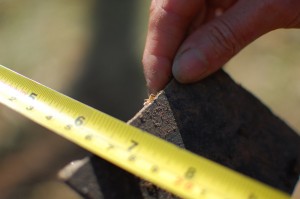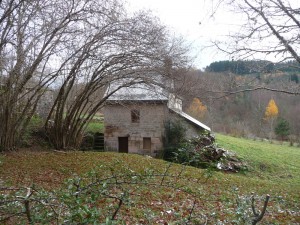 One of the great things about living in a climate that enjoys distinct seasons is how the changes affect the look of the surrounding landscape. Sometimes the changes are so dramatic, and take place over such a short period of time, that it feels like you have awoken to an entirely new environment.
One of the great things about living in a climate that enjoys distinct seasons is how the changes affect the look of the surrounding landscape. Sometimes the changes are so dramatic, and take place over such a short period of time, that it feels like you have awoken to an entirely new environment.
Author Archives: lenteur
Wood shed
 It will take several years before the cycle that we started last winter to grow firewood will yield anywhere near the amount we will need, and so for now we will be buying metre lengths of well seasoned wood from a neighbouring hamlet.
It will take several years before the cycle that we started last winter to grow firewood will yield anywhere near the amount we will need, and so for now we will be buying metre lengths of well seasoned wood from a neighbouring hamlet.
Regardless of where it comes from, the wood will need to be stored somewhere. Moving here mid winter last year, with changes to absorb and many things to take care of, we had no time to build a shelter, and simply stacked the load that we bought under a tarpaulin topped off with corrugated steel. Effective, but aesthetically lacking, and a pain to negotiate.
So, we found ourselves in need of a shed.
Storm
 The vibrant purple violet spot rising above the trees at the head of the valley, and the distant rumble from beyond the horizon, indicate that violence is approaching.
The vibrant purple violet spot rising above the trees at the head of the valley, and the distant rumble from beyond the horizon, indicate that violence is approaching.
The flat, deep colour spreads slowly across the sky, and the detail in the more frequent rumbles pushes purposefully through.
A bright flickering, like the charging of a neon strip light, comes from behind the trees across the meadow.
Crickets chirp, unaware, or unconcerned. Dozens of swallows take their last feed in dazzling intertwining circles, then head elsewhere. The long grass waves lazily in the cool breeze.
Conserving plums
 One of the fruit trees along the perimeter fence turns out to be a wild plum, producing small, round, orange/red fruits the size of a large cherry ( when the blossom erupted earlier in the spring we originally thought it was a cherry ).
One of the fruit trees along the perimeter fence turns out to be a wild plum, producing small, round, orange/red fruits the size of a large cherry ( when the blossom erupted earlier in the spring we originally thought it was a cherry ).
Right up until the point of peak ripeness, we thought that the fruit were going to be inedible; they had a very flowery texture, and little flavour. However, following a week or so of strong sunshine, they developed both sugar content and a pleasant acidity, together with the flesh firming nicely, so we decided to pick as much as we could.
After an hour or so’s delicate manouevering of ladders and balancing precariously amongst heavily-laden branches, ‘as much as we could collect’ generated around 15kg of plums. That’s a lot of fruit to devour, even if you do love fresh plums. So, we set about researching how to conserve them.
Pondlife
This was originally sent in an email to a friend. I am sure Friend won’t mind me sharing.
A few weeks ago we started to hear, dead on nightfall, a loud sound similar to a very sick duck start up, and continue throughout the night, all night, right outside the bedroom window, stopping dead on sunrise ( when the cockerels take over ). Following several sleepless nights, I managed to convince myself that the neighbours had erected a very clever solar powered (?) random-noise-emitter protection system for their fowl.
In praise of the artichoke
 To those people, many generations ago, who viewed a field of artichokes, thinking ‘Mmm, they look tastey’. Or rather, ‘Man, I’m hungry, why not try ?’
To those people, many generations ago, who viewed a field of artichokes, thinking ‘Mmm, they look tastey’. Or rather, ‘Man, I’m hungry, why not try ?’
And then somehow, through much trial and error, endless disappointments and continued hunger, worked out how to make them edible, palatable, and enjoyable.
Thankyou
Baby cricket
 We were digging in the garden this afternoon when a very pale creature wriggling in the dirt caught our eye.
We were digging in the garden this afternoon when a very pale creature wriggling in the dirt caught our eye.
Thinking it might be a maggot or similar, I picked it up on the end of the ruler to take a closer look.
Much more interesting than a maggot, it turned out to be a baby cricket. At least, we’re assuming it was a baby, given its size, just a few millimeters in length.
For all the noise that its fully grown comrades make, we have not yet managed to catch site of one, so to find this tiny thing, and for it to give us enough time to run and find the camera and take a number of photos was something else.
100% rye bread – sourdough starter culture
[ Apologies for the light in some of the photos, they were taken when we were in the midst of an epic thunderstorm ]
In advance of trying out the bread oven we decided to try to perfect the recipe of the type of bread we hope to make. We are intending to make a 100% rye sourdough bread, and also attempt a Vollkornbrot and a Pumpernickel, both of which are made with whole and chopped grains in addition to flour, the Pumpernickel being baked for a very long time at a low temperature.
The basis of good sourdough bread is a healthy sourdough culture. The culture is used in place of bakers yeast, and creates a bread that has a fuller flavour, with excellent keeping qualities. It also creates a more nutritious bread, less likely to aggravate intollerances, because the ingredients are fully fermented over a long period of time and transformed into a more readily digested food.
Making sourdough bread is a process that is spread over a longer period of time than when using fast-acting bakers yeast, but for the majority of that time, the bread is proving, doing its bread thing. The amount of time spent by the baker actually doing anything is not greatly increased.
Sourdough cultures are living entities. They need to be fed on a regular basis in order to be kept alive and in peak condition. The microorganisms within the culture are responsible for the magic that transforms a set of very basic ingredients into bread; you want to keep them happy.
Installing a French drain
The first, and most important work we needed to undertake when renovating this property was to install a French drain. Named not after the country, but after the person who came up with the system.
The house is built into an earth bank, with no protection, in an area known for an abundance of natural springs. This means that the walls absorb and wick moisture, leading to the normal problems associated with damp.
An apology in advance : halfway through this process I bought a new camera, and took a load of photos without really getting to grips with the settings, so the quality isn’t great.
 Step 1: bring in the digger. A big one, for digging big holes. Continue reading
Step 1: bring in the digger. A big one, for digging big holes. Continue reading
Coppicing overgrown hazel

 The only form of heating we have in the house are two wood burners. It’s a very small property, has no need of expensive and overly complicated central heating. It makes for a very cosy environment, but does require us to source fuel, rather than simply being able to flick a switch.
The only form of heating we have in the house are two wood burners. It’s a very small property, has no need of expensive and overly complicated central heating. It makes for a very cosy environment, but does require us to source fuel, rather than simply being able to flick a switch.
A partial answer to this requirement is to grow our own. We don’t have sufficient land to grow all of the wood we will need each winter, but we will be able to produce some of it. Continue reading
